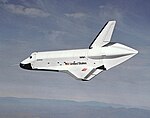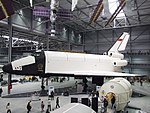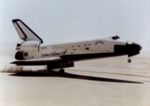Comparison of Buran and Space Shuttle
The Buran ( Russian Буран for Buran - snowstorm) was a Soviet space shuttle , which outwardly resembled the US space shuttle and was never used in manned operations. The space shuttle is a type of space shuttle developed by NASA in the USA.
Both space shuttles are very similar in appearance, but have conceptual differences.
Main differences

Buran space shuttle in a model

Space Shuttle “Discovery” preparing for launch
- The most obvious difference is that the Buran as a payload of the rocket Energija was started while the space shuttle with its SSME is itself -Haupttriebwerken the rocket, but the external fuel tank mitträgt. The space shuttle has elaborate on-board fuel pumps and additional technology that the Buran did without. The Energija was also able to transport other payloads with a mass of up to 80 tons (up to 150 tons if additional boosters were attached) into space - as happened at the first launch. Four liquid fuel boosters were used to launch the Buran - instead of two solid fuel boosters as in the space shuttles. They burned kerosene and liquid oxygen and, equipped with an upper stage, could be used as independent Zenit rockets.
- The Buran was designed for both manned and fully automatic flight and could land fully automatically. The manned version was never brought into a bootable state. At the request of the astronauts, the US counterpart was not originally intended for unmanned use. The landing gear in particular was deliberately only to be operated manually. It was only since STS-121 (July 2006) that it was possible to bring the space shuttle back to earth unmanned and remotely controlled in an emergency. However, these systems have never been tested in real use.
- The Buran had no heavy engines like the shuttle, but rather relatively small engines for maneuvering and attitude control. The elimination of the large engines meant a greater payload of the space shuttle itself. The largest structure of the entire system was not a fuel tank as in the space shuttle, but the launcher.
- The Energija launcher - including the booster - was designed to be reusable. The boosters and the drive part of the central stage with the RD-0120 main engines were supposed to return to earth and land with the help of parachutes. Reusability was never implemented due to budget cuts. The US shuttle has reusable engines in the space shuttle, as well as reusable boosters that can be used again after extensive inspections and restoration work.
- At Buran two jet engines were provided as cruise engines. Due to the poor distribution of the emergency landing sites, especially in the Atlantic and Pacific regions, there was a need to be able to cover longer distances when landing. Due to delays and payload problems with the first Energija version, the Orbiter's engines were not installed on the first flight and the bays on both sides of the vertical stabilizer were closed. These installation bays can still be made out on various rear views of the orbiter versions and various schemes. The two cruise engines were to be protected by front flaps and heat protection jackets upon re-entry. The two upper engines of the OK-GLI prototype correspond to this concept and also have the flaps at the inlet, which, if only used for atmospheric test purposes, would not only have been useless, but would also have reduced performance. In the space shuttle, jet engines were examined as possible cruise engines, but dropped early due to payload considerations and better distribution of suitable emergency landing sites.
- According to the calculations, the Buran could have carried 30 tons into orbit , compared to the 25 tons of the space shuttle. However, proof of these plan parameters has not been provided in practice.
- The ratio of lift to drag in gliding flight ( glide ratio ) is 6.5 for the Buran and 5.5 for the Space Shuttle. Therefore, the Russian space shuttle could have brought 20 tons of payload back to Earth instead of 15 tons for the space shuttle.
- The arrangement of the heat protection tiles is different: Continuous joints in the Buran are at right angles and short joints parallel to the plasma flow (direction of air flow), not at a 45-degree angle as in the space shuttle.
- By default, were of NPP Zvezda made K-36RB- ejection seats in conjunction with Strisch - pressure suits designed to protect the crew. According to the manufacturer, these should be usable for speeds of up to Mach 3 and heights of up to 30 km. In the accidents with the US space shuttle, such ejection seats might have saved lives in the case of the Challenger in 1986 , but not in the case of the Columbia in 2003 (60 km altitude, Mach 23).
- The nozzles for maneuvering in orbit on the space shuttle were operated with the hypergolic mixture of nitrous tetroxide and dimethylhydrazine , while the Buran used liquid oxygen ( LOX ) and sintin . The solution used at Buran was more efficient and safer to handle on the ground. In addition, the liquid oxygen could be used in an emergency to generate electricity in the fuel cells or for the life support system. However, the system was heavier and more complex. In the 1990s there were plans to convert the space shuttle to a LOX / ethanol mixture for the control nozzles.
Technical details
| Space shuttle | Buran | |
|---|---|---|
| Orbiter | ||
| length | 37.25 m | 36.37 m |
| span | 23.80 m | 23.92 m |
| height | 17.25 m | 16.35 m |
| Dry matter | 78 t | 61 t |
| Max. Take-off mass | 110 t | 105 t |
| Max. crew | 8th | 10 |
| Direction of flow / heat protection tiles |

|

|
| Payload Bay | ||
| length | 18.29 m | 18.55 m |
| width | 4.57 m | 4.65 m |
| Starting capacity | 25 t | 30 t |
| Landing capacity | 15 t | 20 t |
- Remarks
- The dry mass of the space shuttle varies slightly per orbiter. The take-off payload capacity of both systems is heavily dependent on the orbit height and the orbit angle .
- The technical parameters of the Buran could not be checked due to a lack of continuous use in space.
Comparison of the prototypes
| Surname | image | function | comment | function | image | Surname |
|---|---|---|---|---|---|---|
| There is no known mock-up of the Buran program that was created before effective development began, also because the program was ordered by the state leadership directly to the space industry by decree |
A model made of wood and plastic served as inspiration, with which North American Rockwell applied for the contract to manufacture the orbiters for the space shuttle program with the US government. |

|
inspiration | |||
| Not an official name |

|
Wind tunnel model, scale 1: 3 | For the Buran program, a wooden model with sensors on a scale of 1: 3 was created (no wind tunnel model of this size was built for the space shuttle program.) | |||
| OK-1M OK-M OK-ML-1 BTS-001 OK 0.01 |

|
For static tests and handling | OK-1M, like OV-101, was used for integration tests and launchpad tests, but was not airworthy | For aerodynamic tests and astronaut training on handling in the approach phase, integration tests on the launchpad and vibration tests |

|
OV-101 Enterprise |
| OK-2M OK-GLI BTS-002 OK 0.02 |

|
For aerodynamic tests and cosmonaut training for handling in the approach phase | Like the Enterprise, the BTS-002 / OK-GLI was used for aerodynamic tests and for gathering experience during the approach. In contrast to the OV-101, the BTS-002 has four jet engines and could start on its own, so that it did not have to be transported with carrier aircraft such as the Myasishchev WM-T "Atlant" or the Antonov An-225 . The OV-101 was important for the validation of the B747- SCA verification. |
|||
| OK-3M OK-KS OK 0.03 |
[1] | OK-3M was used to test all electronic systems of the space shuttle in a realistic mock-up. A complete space shuttle hull including landing gear was built. Only the correction engines were installed later. A special feature of OK-3M compared to all other mock-ups and orbiters is the CCCP lettering on the side walls. |
In contrast to the OK-3M, the electronic systems for the Space Shuttle were not tested in a complete mock-up, but in several small partial test systems. | |||
| OK-4M OK-MT OK-ML-2 OK 0.04 |
[2] | Handling mock-up to verify and train the processes in Baikonur | For the actual tests, the OV-098 was initially not very detailed, while the exterior of the OK-4M was almost identical to the real orbiter. OV-98 was only visually reworked as an exhibit. |
To test the handling and construction of space shuttles. Initially a rudimentary model, later expanded into a full-fledged mock-up using the MPTA-098 engine. |

|
OV-098 MPTA-098 Pathfinder |
| OK-5M OK 0.05 |
Complete front fuselage including heat protection tiles that was used for various tests (heat, vacuum, life support ...). | OK-5M was used to build OK-7M after the cabin-related tests were completed. No equivalent has been created for the space shuttle program. |
||||
| OK-6M OK-TVI OK 0.06 |
[3] | Test of correction engines, main engines, tanks and energy supply | Since Buran does not have any engines like the Space Shuttle, these two systems can only be compared to a limited extent. However, due to the different configuration, there were tests with the engines of the Energjia core stage |
The Main Propulsion Test Article is used to test and apply force to the main shuttle engines. |

|
MPTA-098 Main Propulsion Test Article |
| OK-7M OK-TVA OK 0.15 |

|
For structural and thermal tests | Like OV-099, OK-7M was used for structural tests, unlike OV-099, the expansion into a (space) airworthy orbiter was not planned. | Structural tests, upgrading to a functional orbiter |
 en: File: Space Shuttle Challenger as STA-099.jpg |
STA-099 OV-099 Challenger |
| OK-8M OK 0.08 |

|
Used for heat and vacuum tests without a thermal outer shell to test the crew comparison | There is no equivalent in the US shuttle program |
Orbiter
| Surname | image | comment | image | Surname |
|---|---|---|---|---|
| OK-1K1 Buran Buran 1.01 OK 1.01 GRAY index 11F35 K1 |

|
Buran 1, unmanned flight, destroyed after hangar collapse. A completion in Baikonur was necessary because the An-225 was not yet available. Columbia, first space shuttle to enter orbit. Destroyed on re-entry in 2003 (see STS-107 ) |

|
OV-102 Columbia |
| OK-1K2 Ptitschka Buran 1.02 OK 1.02 GRAY index 11F35 K2 |
[4] | The OV-099 was the second space shuttle, it was built from the static test cell. OV-099 was destroyed on take-off (see Challenger disaster ), the OV-105 was built as a replacement. The OK 1.02 was built as the second orbiter of the USSR and almost 95% completed. Integration tests on the launch pad were carried out. The orbiter has been in a hangar in Baikonur since the end of the Buran program. A completion in Baikonur was necessary because the An-225 was not yet available. |

|
STA-099 OV-099 Challenger |
| OK-2K1 Baikal OK 2.01 GRAY index 11F35 K3 |

|
OV-103 Discovery was the third US spaceflight orbiter. OK-2K1 was the 3rd orbiter of the USSR, modernized version of the two previous space shuttles. A completion in the production plant was planned, since now the An-225 would have been available. The orbiter was only about 50% completed due to the end of the Buran program and is located in the Mikhail Gromov Institute for Flight Research |

|
OV-103 Discovery |
| OK-2K2 OK 2.02 GRAY index 11F35 K4 |
[5] | OK-2K2 was the second orbiter of the modernized version. Was only about 20% complete when the program ended. OV-104 was the 4th US orbiter and was originally planned to complete the orbiter series. |

|
OV-104 Atlantis |
| OK-2K3 OK 2.03 GRAY index 11F35 K5 |
OK-2K3 was the last of the 5 planned orbiters of the Buran program. Only components were created, these were apparently scrapped after the end of the program. The OV-105 Endeavor is the youngest orbiter, it was built to replace the OV-099 from spare parts and with more modern systems. |

|
OV-105 Endeavor |
Transport of the components
- Booster, Energjia strap-ons.
- The space shuttle boosters were transported in segments, which enables them to be transported by truck, train, ship or air freight. The assembly took place near the launch site.
- The Energjia's strap-ons are based on the Zenit rocket. When designing the Zenit, the dimensions were chosen so that it could be transported by rail. It would have been possible to transport several strap-ons in the hold of the An-124 or An-225 . The Buran Energjia program planned to build three An-225s.
- The Space Shuttle External Tank was transported from the manufacturer to the Space Center by ship (cargo barge).
- The Energjia was transported in two components by air freight, with the separation point between the hydrogen and oxygen (LH2 / LOX) tanks. To improve the aerodynamics during transport as an external load, there were two different covers for the two components. These two covers were then put together and also transported back to the Energjia manufacturer as an external load. All Energjia missiles were transported with the Myasishchev WM-T "Atlant" transporters. After the completion of the three planned An-225s, it was planned to use them to transport the Energija instead of the two WM-Ts.
- The US shuttles were transported with the two Boeing 747 Shuttle Carrier Aircraft , SCA. In addition to these transports, the SCA were also used to transport the Enterprise to the necessary height from where it could make the landing approach in gliding flight. In connection with the US shuttle program, only the Enterprise and the spaceflight orbiters were transported by the Shuttle Carrier Aircraft, SCA, no further test samples or components of the Shuttle program. In the early stages of the US shuttle program, transportation as an external load on a C-5 Galaxy was considered, but was rejected as an external load in front of this control unit because of its T-tail and the shuttle's aerodynamic problems.
- In the Buran program, two functional models were transported to Baikonur with the Myasishchev WM-T "Atlant", as well as the first two orbiters. The orbiters were not yet completed, heat protection tiles, rudder units, engines, landing gear, etc. were not installed, otherwise the weight would have been too high for transport with the WM-T. Further transports of the orbiters with the WM-T were not planned because with the completion of the An-225 an aircraft was available that could transport the fully equipped space shuttles without any problems. In addition, an aerodynamic rear cover for the Orbiter was no longer necessary during transport with the An-225. This was necessary for the Shuttle Carrier Aircraft SCA of the USA (apart from some sliding attempts by the Enterprise) and the transports with the WM-T. For the Buran program, a modification of the An-22 as a transporter was considered before the construction of the An-225 and the WM-T , but was discarded.
literature
- Bart Hendrikx Bert Vis: Energiya-Buran The Soviet Space Shuttle. ISBN 978-0-387-69848-9
Web links
Commons : Buran space shuttle - album with pictures
Commons : Space Shuttle - Album with Pictures
Individual evidence
- ↑ Stephen J. Garber: Birds of a Feather? How Politics and Culture Affected the Designs of the US Space Shuttle and the Soviet Buran. . January 2002
- ↑ Vadim Lukashevich: Buran Orbiter .
- ↑ Buran Composition Turbojets on buran-energia.com
- ↑ Buran Composition Heat shield on buran-energia.com
- ↑ NPP Zvezda: Emergency Escape Systems ( Memento from January 15, 2013 in the Internet Archive )